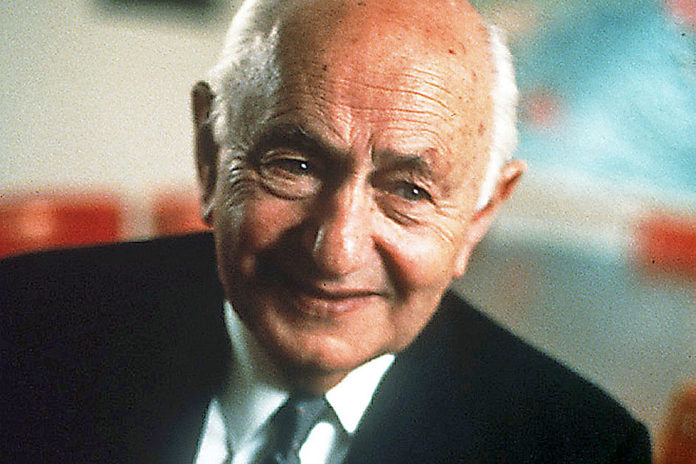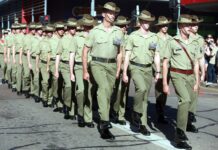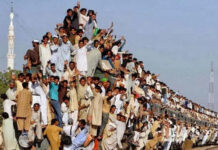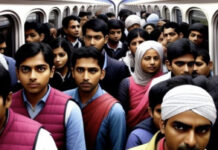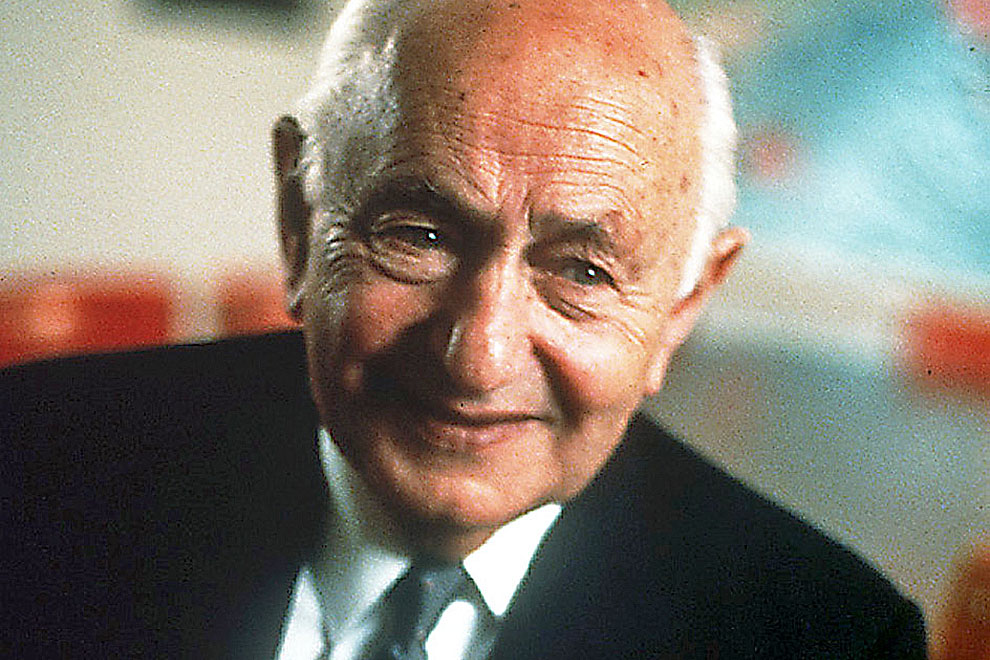
The Democratic Labor Party was formed as a result of the 1955 Australian Labor split, the last of a trilogy of party divisions that the ALP suffered. The first in 1916 occurred over conscription and the second in 1931 occurred over economic responses to the Great Depression. The 1955 split, however, came to be because of communism.
The Cold War had rocked Australia as the red spectre had now moved to swallow the millions of Europeans that lived between Moscow and East Berlin and in 1949 with the victory of the Chinese Communists it spread to hundreds of millions more. It was no longer a stage where the heroic gallantry of the day proved the point, but rather the shame of the so-called Holocaust. It was here that the great narrative was forged and where the great descent began.
But the descent was doubled over by the presence of Communists infiltrating the Australian labour movement, trade union after trade union during the 1930s and 1940s. To combat this, the Labor Party formed “Industrial Groups”. These people would work within the trade unions to ostracise and out-muscle any communist subversion. Given that such connections between the ALP and communism had been used in elections since 1919, it was no surprise that the Industrial Groups were to the party’s advantage.
At the same time, Bartholomew Augustine Santamaria co-founded The Catholic Worker in 1936, a newspaper influenced by the Pope Leo XIII’s encyclical Rerum Novarum, which criticised socialism and unrestrained capitalism. The son of a greengrocer and a recent graduate from the University of Melbourne, B.A. Santamaria would establish the “Catholic Social Studies Movement” or the “Movement” in 1941 as a foundation for anti-communist and Catholic activism in Australia. During the 1940s, the Movement would make its way into controlling the ALP’s Industrial Groups, thereby exercising influence in their own way.
The fight for Australia’s future began in 1949, when Australia had Robert Menzies as Prime Minister for a second term. Menzies was a master of radio communication as he exploited the public distaste for wartime rationing, Ben Chifley’s response to the 1949 Coal Strike as well as communism in general for his victory. His radio speech in 1942 talked about “The Forgotten People,” Australians that were neither wealthy or organised in the likeness of the unions. It ought to have been a rallying cry for Whites to resist the Americanised system of “muh individualism” and the internationalist-statist model of state-run industries under Fabian principles. It instead became a tool to combat the threat of communism as well as the threats that communism made against the “Free World”. Instead Australians were chaining themselves to the struggle of Capitalism against Communism. The threat of Soviet Russia and its international organs as well as the falsehood of the Holocaust meant that the Australian Labor Party, a party founded on democratic socialism and supportive of White Australia, would have to fight the international struggle as well without a choice. The Industrial Groups and the ALP began to conflict from 1945 onwards, rising as H.V. Evatt became ALP leader after Ben Chifley’s death in 1951.
The 1954 Election was a bitter loss for the ALP, with four seats separating him from government. The Petrov Affair (Soviet diplomat and wife defecting to Australia) during the election was masterminded by Menzies and security agencies to discredit the ALP, according to Evatt’s own beliefs. The Royal Commission afterwards showed a Soviet spy ring in Australia that also involved two of Evatt’s staff members. Evatt himself would not only defend his staffers, but also cross examine the key ASIO operative Michael Bialoguski, a Polish Jew. The examination unsettled the government and the Commission withdrew Evatt’s leave to appear before them.
The Petrov Affair and the election loss led Evatt on 5 October 1954 to criticise “the Groupers”, supporters of Santamaria in the ALP that had been criticising Evatt’s leadership and stance on communism. Protestant and left-wing ALP members detested Santamaria and his faction. Robert Holt, the Victorian Minister of Lands under John Cain Snr, sent a letter to the Sydney Sun-Herald on 31 October 1954. Holt described the influence that Santamaria had in the ALP, where Santamaria and Frank Scully (Cain Sr Government Minister) stated that he would not be re-elected if he did not use his position to make lands open to “Italians with foreign capital”. Holt’s letter also stated that opposition to his pre-selection was present and that it was against party policy. He stated:
“My charge is that the Victorian branch is controlled and directed in the main by one group or section through Mr. B. Santamaria … My criticism is not personal. It is leveled against those ideas which are contrary to what I believe Labor policy to be. Moreover, I have been requested by my numerous and trusted friends, who happen to be Catholic, to fight against the influence of Mr. Santamaria and those he represents, when he seeks to implement his ideas through an abuse of a political movement, designed to serve a truly political purpose.”
The letter confirmed that tensions existed. Early 1955 was when the Labor Party’s Federal executive dissolved the Victorian state executive and replaced it with a new one. Both executives sent representatives to the 1955 National Conference in Hobart. The delegates of the old executive were excluded and the Victorian contingent openly rifted between pro-Evatt and pro-Santamaria camps. In March, 24 members of state Parliament were suspended for suspected ties to Santamaria. Four of John Cain Sr’s Ministers had to resign and four trade unions broke away from the ALP. Henry Bolte, the Liberal Opposition leader in Victoria, defeated Cain Sr in a vote of no-confidence on 19 April before becoming Premier in the May 1955 Election. The expelled members formed the Australian Labor Party (Anti-Communist), drawing 12.6% of the state vote.
Catholics such as Arthur Calwell opposed the split altogether, seeing it as a devastating setback given the loss to the Coalition in the previous year. Calwell recognised the reality of the Labor Party splitting, having been in the ALP during the 1916 and 1931 Splits. Calwell would write in his 1972 book, Be just and fear not, quote:
“I have witnessed three disastrous splits in the Australian Labor Party during the past fifty-six years…The first split occurred in 1916 over conscription in World War I; the second in 1931 over the Premier’s Plan for economic recovery in the Great Depression; and the third in 1955 over alleged communist infiltration of the trade union movement. The last was the worst of the three, because the party has not yet healed the wounds that resulted from it.”
The split had destroyed the ALP’s electoral chances and from 1949 it remained in the wilderness. In 1957, the ALP (Anti-Communist) formed the Democratic Labour Party. The DLP would use their preferences and send them towards the Liberal/National Coalition. It led to the 1961 Election being given to the Coalition and its two-seat majority, denying Arthur Calwell the chance to be PM.
The ALP was racked over the coals for its supposed ties to communist groups. I don’t deny that there is a link, but it became a bloody red flag which led Menzies and Holt to run roughshod over the Australian people. The 1955 Split, not the election of Gough Whitlam in 1972, killed off the White Australia Policy. It denied a chance for H.V. Evatt or Arthur Calwell to lead the country on its racial path. The racial path would have been the establishment of a homogenous population to then be followed up by institutions and government services mandating the need for that homogenous population. The DLP’s commitment to anti-communism played into the narrative of the internationalist order, which began to undermine the immigration laws which established this country in the name of capitalism. Catholic schools were given larger government grants, defence spending was increased and non-recognition of the People’s Republic of China.
Calwell was able to bring the DLP to a conference in 1965 in the hopes of re-union. After losing the 1961 and 1963 Elections, it was the least that could be done, with 1963 being the ALP’s seventh defeat in a row. Calwell refused to compromise on the matter of sharing power on a membership number basis. He is perhaps the first man I would have voted for as Prime Minister without hesitation. Not because of shared Catholicism, but of his other merits: A staunch defender of the White Australia Policy even in the 1970s, a supporter of bank nationalisation, an opponent of the Vietnam War as well as fierce advocate against the communist influence in the trade unions and the ALP. His opposition to the Vietnam War versus B.A. Santamaria’s support for it boggles the minds of many nativists to this day. Calwell was an officer of the Australian Army Cadets and made two applications for a commission in the Australian Imperial Force. In other words, he wanted to act for his country. But he remained in the Army Reserve until his discharge in 1926. The man acted for his country even when he was unable to fight. He was the subject of an assassination attempt in 1966 courtesy of a mentally-ill 19-year old Peter Kocan and remained dedicated to White Australia even when politics demanded otherwise.
As for B.A. Santamaria, he was the subject of controversy because he received an exemption from military service in WW2. In 1972 Calwell stated that Santamaria had been granted an exemption at the behest of then-Archbishop of Melbourne, Daniel Mannix, which Santamaria denied. Calwell doubled down on his view of Santamaria and two other men who had supported the Vietnam War and yet refused to serve in WW2, quote:
“I regret that these people who benefited from our generosity did not beget any children who went out to fight in the war in Vietnam. Their sons were exempted, all of them, because they were employed in reserve institutions as were their fathers.” – The Canberra Times, 24 February 1972.
In May 1972, documents were found confirming Calwell’s version of events.
The ALP’s policy on White Australia was killed in 1955 and the defeat of Whitlam in 1975 meant that the ALP could no longer work on behalf of the White Australian workers. Instead they ditched it for leftism courtesy of Gough Whitlam (regarded by some boomers and millennials as a saint) and neoliberalism courtesy of Bill Hayden and Bob Hawke and Paul Keating, Hawke whom we can now confirm was an informant for the US alongside B.A. Santamaria and Keating whose daughter was in the same circles as Prince Andrew and Jeffrey Epstein.
Funny how things turn out like that, don’t they.
As for the DLP proper, it drifted into decline. The DLP’s Parliamentarians grew older and the attitudes within the Catholic Church began to change as sectarianism dropped away in the 1970s. Apart from the election of Federal Victoria Senator John Madigan from 2011-2014, the federal DLP was deregistered in 2020 due to an inability to prove it had 1500 members. However the party remains registered in Victoria and the ACT.
The DLP had not seen great success post-Whitlam, after contributing to the end of White Australia and the collapse of the system that had made Australia. The DLP represented those that saw race as something that should not count in terms of immigration. In May 1972, Arthur Calwell responded to the Ecumenical Council of Australia’s stance on White Australia, quote:
“I am neither terrorised nor influenced by the pious outpouring of those prelates who seek to stigmatize all red-blooded Australians who want to keep this country as our pioneers, those who were born here or came here before Federation, made it. Why can’t the bishops develop a new theory on war? When will most of our Christian clergy stop pandering to the middle class in our supposedly Christian community and stop posturing when it comes to opening the floodgates to unwanted and unnecessary coloured migrants? The silence of Dean Maitland was eloquent alongside the mammoth silence of most of our church leaders on everything associated with the brutal, filthy, immoral, unwinnable, criminal, genocidal, civil war in Vietnam, Laos and Cambodia.”
The point is made clear. Why can’t this nation remain as it was before Federation? Calwell understood the nature of race and religion as did many people who stayed in the ranks of the ALP. They wanted to have White Australia and they wanted nothing of the Vietnam War let alone the Cold War and they were called cowards and ingrates for wanting to keep their blood within the borders instead of spilling it overseas! The DLP made this fatal error in 1955 to fight against communism and not for White Australia. Because of that, we have the modern situation of the day: to vote between being raped today or being raped today with a condom. Otherwise there will be a fine issued.
While there is no political solution, there is no harm in sending a message.
You can find Australian Nativist at Telegram.

